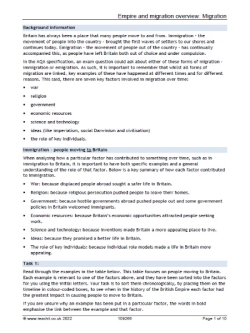Empire and migration overview: Migration

This introduction or review lesson provides GCSE students with examples of reasons for immigration to Britain and emigration from Britain, sorted into AQA's seven factors:
- War
- Religion
- Government
- Economic resources
- Science and technology
- Ideas
- The role of key individuals.
Students match the factors to the reasons for their influence then place the examples on a timeline to see which factors had the greatest impact at different periods of time.
The examples of immigration range from Viking settlers in around 790 to the Windrush generation in the 1940s and 1950s, while the examples of emigration include the Pilgrim Fathers, the Ulster Plantations and freedom of movement within the European Union.
The lesson is part of the following mini scheme:
- A teacher’s overview of how this unit might be taught thematically (38-lesson plan)
- An overview resource for ‘Gaining an empire’
- An overview resource for ‘Losing an empire’
- An overview resource for migration
- An overview resource for developing English and British identities
- A guide to AQA’s question styles for this unit, with model answers and walk-throughs for students.
An extract from the resource:
Task 1:
Read through the examples in the table below. This table focuses on people moving to Britain. Each example is relevant to one of the factors above, and they have been sorted into the factors for you using the initial letters. Your task is to sort them chronologically, by placing them on the timeline in colour-coded boxes, to see when in the history of the British Empire each factor had the greatest impact in causing people to move to Britain.
